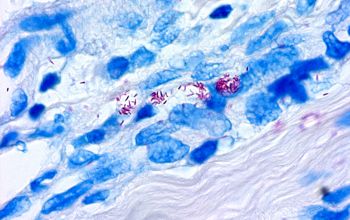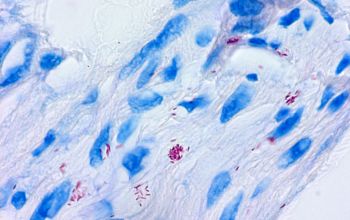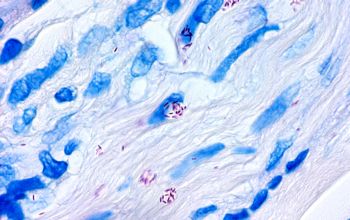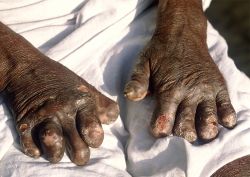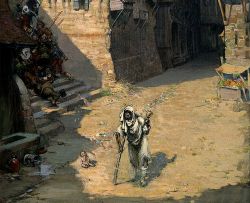Hands deformed by leprosy,
1990, India
photo B.jehle - Own work
https://commons.wikimedia.org/wiki/File:Leprosy_deformities_hands.jpg
A bishop instructing clerics suffering from leprosy from Omne Bonum by 14th-century clerk James le Palmer (British Library, MS Royal 6 E VI, vol. 2, fol. 301ra).
Medieval depictions of leprosy commonly showed the victim to have red spots.
photo wikimedia commons
https://commons.wikimedia.org/wiki/File:Leprosy_victims_taught_by_bishop.jpg
People scrambling to get away from a leper, in their haste the crowd has left an infant on the roadside, the leper strolls by, ringing a bell; representing attitudes to leprosy.
Watercolour by R. Cooper.
By: Richard Tennant Cooper Published
wikimedia commons
https://commons.wikimedia.org/wiki/File:People_scrambling_to_get_away_from_a_leper,_in_their_haste_t_Wellcome_V0017056.jpg
Mycobacterium leprae
-
General information
Leprosy is also known as Hansen’s disease, after the scientist who discovered M. leprae in 1873.
Taxonomy
Family: Mycobacteriaceae
History
Leprosy has been around since ancient times, often surrounded by terrifying, negative stigmas and tales of leprosy patients being shunned as outcasts.
Outbreaks of leprosy have affected, and panicked, people on every continent.
The oldest civilizations of China and Egypt, and India feared leprosy was an incurable, mutilating, and contagious disease.
Natural habitats
This bacteria is believed to live in the soil.
Scientists think that the reservoir for this bacteria is the new world armadillos and African primates.
At the beginning the idea that the habitat of this bacteria was in soil was just an hypothesis but some research were done and DNA of the M. leprae was found in soil close to where people were infected with leprosy.
Its ideal temperature is about 30-33oC
Clinical significance
Leprosy
Is an infectious disease that causes severe, disfiguring skin sores and nerve damage in the arms and legs.
Leprosy is actually not that contagious.
You can catch it only if you come into close and repeated contact with nose and mouth droplets from someone with untreated leprosy.
Children are more likely to get leprosy than adults.
Symptoms
Leprosy primarily affects the skin and the nerves outside the brain and spinal cord, called the peripheral nerves.
It may also strike the eyes and the thin tissue lining the inside of the nose.
The main symptom of leprosy is disfiguring skin sores, lumps, or bumps that do not go away after several weeks or months.
The skin sores are pale-colored.
It usually takes about 3 to 5 years for symptoms to appear after coming into contact with the leprosy-causing bacteria. Some people do not develop symptoms until 20 years later.
There are three forms of the disease, with lepromatous being the most severe, tuberculoid, and borderline leprosy.
The precise mode of transmission is not fully understood.
The bacteria are likely spread by direct contact and through air dispersement, from coughing or sneezing.
Manifestations
Infected individuals will notice skin lesions in early stages, leader to paralysis or loss of sensation in those areas, and eventually loss of extremities.
Blindness can occur as the disease advances.
-
Diseases
-
Gram stain
Gram positive rods,
with a thick waxy coating.
Due to this coating, it cannot be stained with the Gram method.
Acid-fast
It is a strongly acid-fast rod shaped organism with parallel sides and rounded ends.
It occurs in large numbers in the lesions of lepromatous leprosy, chiefly in masses with the lepra cells, often grouped together like bundles of cigars or arranged in a palisade.
Chains are never seen.
Most striking are the intracellular and extra-cellular masses, known as globi, which consist of clumps of bacilli in capsular material.
It is believed that only leprosy bacilli which stain with carbol-fuchsin as solid acid-fast rods are viable and that bacilli which stain irregularly are probably dead and degenerating
In size and shape, it closes resembles M. tuberculosis
-
Culture characteristics
-
Obligate aerobic
M. leprae has never been grown in artificial culture, but will grow in the footpads of mice and in armadillos.
The culture can take several weeks to mature.
As one of the slowest growing bacteria known and its inability to grow independently, successful in vitro cultivation has never been achieved.
Facultative intracellular growth
-
-
Characteristics
-
References
James Versalovic et al.(2011) Manual of Clinical Microbiology 10th Edition
Clinical and Taxonomic Status of Pathogenic Nonpigmented or Late Pigmenting Rapidly Growing Mycobacteria
Leprosy elimination Microbiology of M. leprae World Health Organization
Leprosy Overview WebMD

